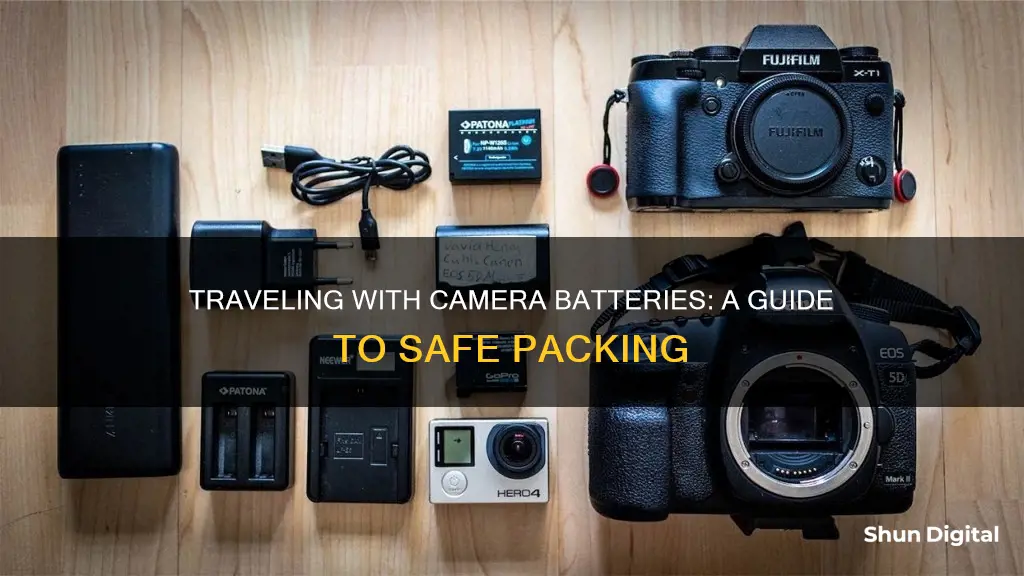
Travelling with camera equipment and batteries can be a daunting task for photographers. With regulations and restrictions on batteries, photographers must be aware of what type of equipment and batteries are allowed on an airplane. It is important to note that there are specific rules enforced by aviation authorities like the FAA or EASA to ensure flight safety. This paragraph aims to provide an overview of the topic and introduce the key considerations for travelling with camera batteries.
| Characteristics | Values |
|---|---|
| Where to store batteries | Hand luggage/carry-on baggage only |
| Number of batteries allowed | Up to 20 spare batteries |
| Weight/watt-hour limit per battery | 100 Wh |
| Weight/watt-hour limit for larger batteries | 101-150 Wh |
| Protection required | Yes, tape across battery contacts to prevent short circuits |
| Packaging | Individual protective cases, plastic bags, or original retail packaging |
| Battery installation | No, batteries should be uninstalled |
What You'll Learn

Lithium batteries must be in hand luggage
When travelling by air, lithium batteries must be packed in your hand luggage. This is because lithium batteries, which power everyday devices, can catch fire if damaged or if the battery terminals are short-circuited. If a lithium battery catches fire in the cargo hold, there is no one available to intervene and stop the fire. Cabin crew, on the other hand, are capable of extinguishing a fire caused by a damaged lithium battery inside the cabin.
The rules for travelling with lithium batteries vary slightly depending on whether they are installed or uninstalled. Installed lithium-ion batteries are generally considered safe and are permitted onboard aircraft. However, the US Federal Aviation Administration (FAA) recommends that devices containing lithium-ion batteries, such as cameras, be kept in carry-on baggage. If these devices are packed in checked baggage, they should be turned off, protected from accidental activation, and packed to prevent damage.
Uninstalled lithium-ion batteries, on the other hand, are prohibited in checked baggage and must be carried in carry-on baggage. This includes spare lithium-ion batteries for cameras, as well as power banks and cell phone battery charging cases. To prevent short circuits, battery terminals should be protected by covering them with tape or keeping them in the manufacturer's packaging. It is also recommended to place each battery in a separate bag.
In addition to these guidelines, there are limits to the number and size of lithium batteries you can carry. Each passenger is limited to two spare batteries. For lithium-ion batteries, each battery must not exceed 100 watt-hours. For lithium metal batteries, the limit is 2 grams of lithium per battery.
Charging Your Vivitar Camera: A Step-by-Step Guide
You may want to see also

Tape battery terminals to prevent short circuits
When travelling with camera batteries, it is important to take precautions to prevent short circuits. Short circuits occur when the positive terminal of a battery comes into direct contact with the negative terminal, without anything in between to slow down the flow of energy. This causes the battery to rapidly dump energy into itself, which, in the case of lithium batteries, can result in dangerous overheating and even fires.
To prevent short circuits, it is crucial to protect the battery terminals. One effective method is to tape the battery terminals. This involves covering the terminals with tape, such as camera tape, to create a barrier between the positive and negative terminals. It is important to avoid using tape that leaves residue or marks, such as parcel tape. By taping the terminals, you can prevent accidental contact between the terminals and reduce the risk of a short circuit.
When taping the battery terminals, it is essential to follow some best practices. First, ensure that you use a suitable type of tape that will not leave any residue. Camera tape is specifically designed for this purpose and is a good option. Second, cut the tape to an appropriate size that covers the terminals adequately without covering any important markings or labels on the battery. Third, apply the tape smoothly and securely to ensure it stays in place and effectively protects the terminals.
In addition to taping the terminals, there are other measures you can take to further reduce the risk of short circuits. One recommendation is to place each battery in a separate bag, providing an extra layer of protection. This helps to ensure that the batteries do not come into direct contact with each other or with other conductive objects. Additionally, always carry spare lithium batteries in your carry-on baggage, as loose lithium batteries in the cargo hold can pose a fire hazard without immediate intervention.
Checking Your Alro Camera's Battery Status: A Step-by-Step Guide
You may want to see also

Keep batteries in original packaging
When travelling with camera batteries, it is important to follow the correct safety procedures. One key recommendation is to keep batteries in their original packaging. This is because the original packaging is designed to protect the battery from environmental factors such as humidity. It also ensures that you can easily identify new, fully charged batteries, and prevents the battery terminals from touching other metal objects.
The original packaging is designed to keep the battery safe and secure. It is made from materials that won't react with the battery and helps to prevent short circuits. The packaging also provides a barrier between the battery terminals and other metal objects, reducing the risk of sparks or heat generation, which could lead to a fire. By keeping the batteries in their original packaging, you can be sure that they are protected and that the terminals are not exposed.
Additionally, the original packaging makes it easier to transport and store the batteries safely. It often includes safety instructions and warnings, which can be important when travelling. The packaging is also designed to be compact and easy to carry, making it convenient for travel. It allows you to store multiple batteries together without them touching, reducing the risk of short circuits and keeping your batteries organised.
Furthermore, the original packaging can help you identify the batteries quickly and easily. This is especially useful when travelling, as it allows you to locate specific batteries without having to open multiple containers or bags. It also helps you keep track of your battery inventory and ensures that you don't confuse old batteries with new ones.
Keeping batteries in their original packaging is a simple and effective way to ensure their safety and longevity when travelling. It provides protection, convenience, and organisation for your camera batteries, giving you peace of mind during your travels.
Shipping a Camera With Battery: The Safe Way
You may want to see also

Remove damaged batteries
When travelling with camera batteries, it is important to remember to never bring damaged batteries on board an aircraft. If a battery has been damaged during your trip, it should be disposed of properly. This is because damaged batteries are considered hazardous and can cause safety incidents, such as sparks that can lead to fires.
Damaged batteries are those that are swollen, corroded, or leaking, and they should be handled and stored with extreme care. When storing a damaged battery, it is recommended to wear gloves to avoid direct skin contact. The battery should be placed in a container of sand or kitty litter, and kept away from metal and stored in a cool, dry place.
It is important to note that damaged lithium-ion batteries have the potential to leak electrolyte or enter thermal runaway. This can lead to fires or explosions. As such, it is crucial to wear proper personal protective equipment (PPE), such as goggles, a face shield, gloves, and an apron when handling these batteries.
For safe storage while awaiting proper disposal, place the battery in a container of cushioning material that is non-combustible, electrically non-conductive, and absorbent. Do not place damaged batteries in the regular trash or recycling containers. If further measures are needed, the damaged battery may be placed in a specially designed storage case, such as a UN-rated container with a lid and a Class 9 hazard label.
When shipping damaged batteries, they must be properly packaged and labelled to comply with the regulations set by the U.S. Department of Transportation (DOT). These guidelines include special handling and clear labelling, and may include restrictions on the transportation method.
The Power of Wyze Cameras: Battery or Plug-in?
You may want to see also

Pack camera gear in the hold
When packing camera gear in the hold, it is important to disassemble your camera equipment. Separate the lens from the camera body, take out the battery, and unclip the camera strap. This will avoid unnecessary wear on any threads and moving parts when the camera moves around in your bag. It will also prevent the camera from accidentally switching on mid-flight and draining the battery.
After disassembling, wrap each component in something padded. Use dedicated padded inserts or cloth wraps made for camera gear. If you don't have these, use soft clothing like cotton t-shirts as the first layer, and then something more padded like a sweater as the second layer. Try to wedge soft items between each component for extra cushioning if you don't have insert dividers.
Place your disassembled and wrapped camera gear inside a sturdy case, such as a Pelican case, to protect it from impact damage. To secure the case, use heavy-duty cable ties instead of padlocks. Cable ties require a sharp blade to break through, which baggage handlers are unlikely to have access to. Additionally, using cable ties makes the contents seem less valuable than if the bag were secured with heavy padlocks. Include some spare cable ties inside the case in case security needs to cut through them to inspect the bag.
Keep in mind that your camera equipment is not completely safe from theft when travelling through baggage systems internationally. Ensure that you have proper camera insurance to cover any potential losses.
Charging Enel3e Camera Battery: Alternative Methods to Try
You may want to see also
Frequently asked questions
Standard dry cell alkaline batteries such as AA, AAA, C, and D can be taken onboard without restrictions. Lithium-ion batteries, which are commonly found in smartphones, laptops, tablets, and camera equipment, have specific rules enforced by aviation authorities.
Lithium-ion batteries must be carried in carry-on baggage only. Each passenger is limited to two spare batteries between 100 and 160 watt-hours per battery. It is also important to protect the battery terminals to prevent short circuits.
It is recommended to keep your camera batteries in your carry-on baggage. You can use the manufacturer's packaging or cover the terminals with tape to isolate them. Some airlines may require you to remove the batteries from your camera and store them separately.
Yes, drone batteries are allowed in carry-on baggage. However, it is important to check the specific rules of the airline you are travelling with, as there may be additional restrictions.
If you have a large number of camera batteries, it is important to check the specific rules of the airline you are travelling with. Some airlines may have restrictions on the number of spare batteries allowed. Additionally, you may want to consider shipping your equipment ahead of time or purchasing additional baggage allowance.







